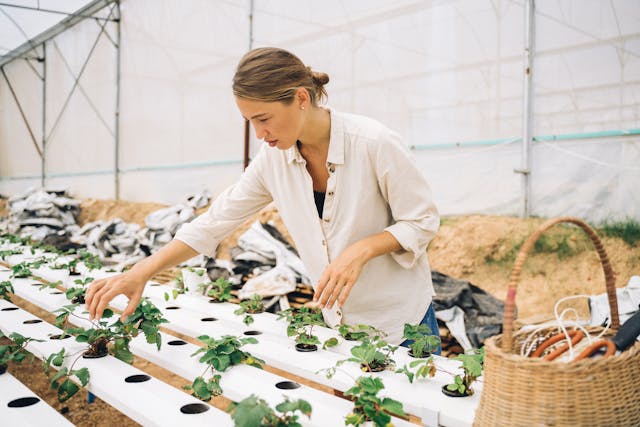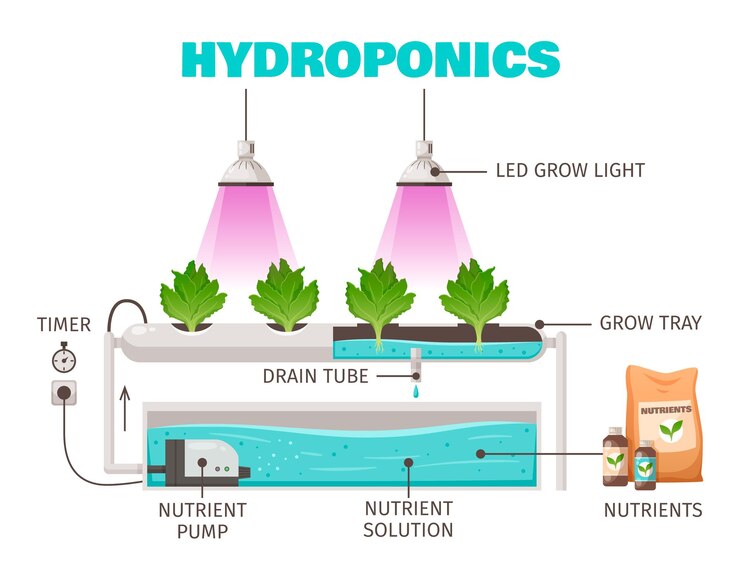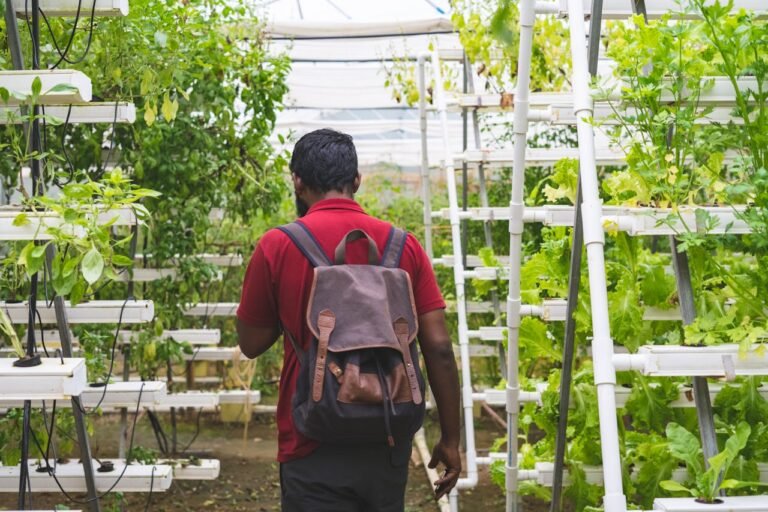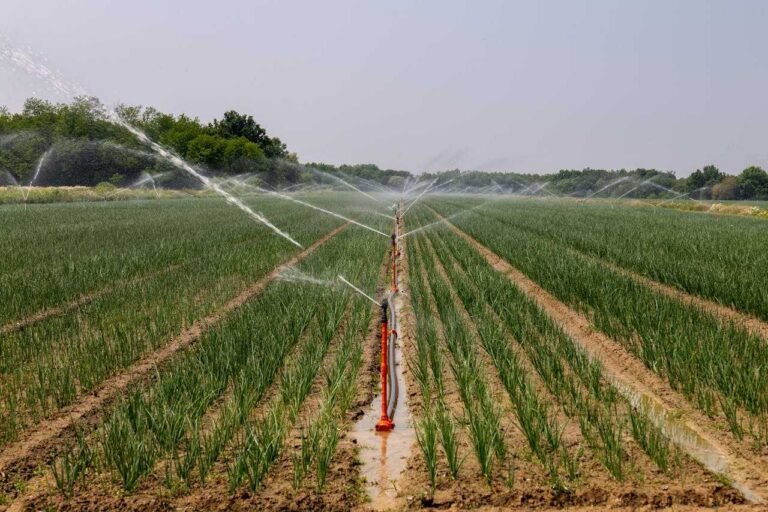What is Vertical Hydroponic Farming? A Complete Guide to Sustainable Urban Agriculture
Imagine walking into a building in the middle of a bustling city and finding rows upon rows of fresh vegetables growing indoors. That’s the magic of vertical hydroponic farming—a space-saving, efficient farming method that holds immense potential for feeding our ever-growing urban population. For me, the journey into hydroponics started out of curiosity, but it quickly became a passion that I believe can revolutionise agriculture and offer a solution to some of the most pressing environmental and food security challenges.
In this guide, we’ll not only cover the essentials of vertical hydroponic farming but also dive into personal stories, expert insights, and practical tips to help you explore or even start your own setup.

In This Article
- My First Step into Hydroponic Farming: A Personal Experience
- Why Vertical Hydroponic Farming?
- What is Vertical Hydroponic Farming?
- The Different Types of Hydroponic Systems
- The Benefits of Vertical Hydroponic Farming
- The Challenges of Hydroponic Farming
- Expert Insights on Vertical Hydroponic Farming
- How to Start Your Own Vertical Hydroponic System
- Real-World Success Stories: Urban Hydroponic Farms Leading the Way
- The Future of Vertical Hydroponic Farming
- Conclusion
My First Step into Hydroponic Farming: A Personal Experience
A few years ago, I had a small rooftop space and the desire to grow my own food. However, living in an urban apartment with limited outdoor space meant traditional gardening wasn’t feasible. I heard about hydroponic systems and decided to give them a try. After setting up a simple vertical hydroponic system on my roof, I was blown away by how much produce I could grow in such a small space.
What started as a hobby quickly turned into a fascination with this modern farming technique. The benefits—reduced water usage, no need for soil, and the ability to grow plants year-round—made me realise that hydroponics could be the key to addressing future food shortages. In this article, I’ll share my journey and guide you through everything you need to know about vertical hydroponic farming.
Why Vertical Hydroponic Farming?
The Global Food Crisis
With the global population expected to exceed 9 billion by 2050, food production must increase by at least 70% to meet the demands of this growing number. However, conventional farming methods are already under strain, facing issues like land degradation, water shortages, and climate change. According to the United Nations, traditional agriculture also contributes significantly to deforestation, which exacerbates global warming.
The Urban Solution
By 2050, 70% of the world’s population will live in urban areas. This is where vertical hydroponic farming becomes essential. It’s an urban agricultural system that maximises limited space, allows for year-round growing, and minimises environmental impacts by using less water and land than traditional farming.
What is Vertical Hydroponic Farming?
At its core, vertical hydroponic farming is a method of growing plants without soil, using nutrient-rich water solutions. Plants are grown in vertical stacks or towers, making them ideal for urban environments where space is at a premium. The beauty of hydroponics lies in its ability to create controlled environments, allowing plants to thrive regardless of external weather conditions.
How It Works
Plants are grown in a soilless medium, such as peat moss or coconut coir, while their roots are submerged in or periodically fed a nutrient solution that provides essential elements like nitrogen, phosphorus, and potassium. Since there’s no soil, plants don’t need to expend energy searching for nutrients, allowing them to grow faster and more efficiently.

Key Components of a Vertical Hydroponic System:
- Grow Towers: These structures hold the plants in vertical rows, maximising space.
- Nutrient Reservoir: A tank that holds the water and nutrient mixture.
- Pump: To circulate the nutrient solution to the plants.
- Grow Lights: In indoor systems, artificial lighting simulates sunlight for photosynthesis.
- Growing Medium: A substitute for soil, such as perlite or coconut coir, helps anchor the plants.
The Different Types of Hydroponic Systems
When I first started, I didn’t know there were several types of hydroponic systems, each with its own advantages. I began with a simple system and later experimented with others. Here’s a breakdown of the most common hydroponic systems used in vertical farming:
1. Wick System
This is one of the simplest hydroponic systems and doesn’t require electricity or pumps. The nutrient solution is delivered to the plants through a wick. It’s best suited for smaller, non-fruit-bearing plants like herbs.
Personal Note: My first experiment with the wick system was in my kitchen, where I grew basil and oregano. The simplicity of the system amazed me, and it worked well for small-scale herb growing.
2. Water Culture
In this system, plant roots are suspended directly in the nutrient solution. It’s an easy system to set up but requires constant oxygenation of the water to prevent root rot.
3. Ebb and Flow (Flood and Drain)
Plants sit in a tray filled with a growing medium like rock wool or perlite. The nutrient solution is periodically pumped into the tray and then drained back into the reservoir. This system is more advanced, but great for a variety of plants.
4. Drip System
The nutrient solution is delivered directly to the plants via a drip line. This system is highly efficient and can be used for larger plants like tomatoes and cucumbers.
5. Nutrient Film Technique (NFT)
In this method, a thin film of nutrient solution flows over the roots of the plants, which are positioned in a slightly tilted trough. The roots are partially exposed to air, which helps prevent over-saturation and root rot.
Table: Comparison of Hydroponic Systems
| System | Complexity | Best For | Water Efficiency | Power Required |
|---|---|---|---|---|
| Wick System | Simple | Herbs, Small Plants | Moderate | No |
| Water Culture | Simple | Lettuce, Spinach | High | Yes |
| Ebb and Flow | Moderate | Medium-Sized Plants | High | Yes |
| Drip System | Moderate | Larger Plants | High | Yes |
| Nutrient Film Technique | Advanced | Herbs, Greens | Very High | Yes |
The Benefits of Vertical Hydroponic Farming
1. Space Efficiency
One of the most compelling reasons to adopt vertical hydroponic farming is its efficient use of space. You can grow significantly more food per square foot compared to traditional farming methods. For example, a vertical farm can produce the same amount of lettuce in 1/10th of the space required by conventional farming.
Personal Insight: When I first built my vertical hydroponic system, I was amazed at how much produce I could grow on my rooftop. It felt like a little urban oasis of fresh greens.
2. Water Conservation
Hydroponics uses up to 90% less water than traditional farming because the water in the system is recirculated. This is a game-changer in areas where water is scarce.
3. Faster Growth and Higher Yields
Because the plants don’t need to expend energy searching for nutrients, they grow faster and produce higher yields. In my experience, crops like lettuce and spinach can be harvested in half the time compared to soil-grown crops.
4. Year-Round Farming
Since hydroponic systems are often set up indoors or in greenhouses, you can grow food year-round, regardless of the weather outside. This is particularly important as climate change leads to more unpredictable growing seasons.
The Challenges of Hydroponic Farming
Like any technology, hydroponic farming isn’t without its challenges. Here are some of the difficulties I encountered when I first started:
1. Initial Costs
Setting up a vertical hydroponic farm can be expensive, especially if you’re opting for advanced systems with automated pumps and grow lights. However, I found that after the initial investment, the operational costs were much lower due to water and space efficiency.
2. Technical Knowledge
There’s a learning curve involved in maintaining the right nutrient balance, ensuring proper water circulation, and managing pests and diseases. I had to experiment and learn through trial and error before getting my system to run smoothly.
Expert Insights on Vertical Hydroponic Farming
I wanted to back up my personal experiences with expert knowledge, so I extracted an excerpt from an interview I came across online by Dr Jessica Green, an agricultural scientist specialising in sustainable farming practices. Here’s what she had to say:
“Hydroponic farming represents the future of urban agriculture. It allows us to grow food in controlled environments, reducing the need for pesticides and using less water. As cities continue to expand, hydroponic systems can play a vital role in ensuring food security.”
Dr. Green emphasised that while hydroponics is promising, it’s not a one-size-fits-all solution. “There are still challenges, particularly around energy use for grow lights and pumps, but advances in renewable energy are making this more sustainable.”
How to Start Your Own Vertical Hydroponic System
Starting a vertical hydroponic farm may seem intimidating, but it’s easier than you think. Here’s a step-by-step guide to get you started.
1. Choose Your Location
Find a space that gets good light. If you’re growing indoors, invest in full-spectrum LED grow lights. Make sure the area is well-ventilated to avoid mould and mildew buildup.
2. Select a Hydroponic System
If you’re a beginner, I recommend starting with a simple wick system or water culture setup. These are inexpensive and easy to maintain. As you gain experience, you can experiment with more advanced systems like NFT or drip systems.
3. Set Up the Growing Medium and Nutrient Solution
Choose a growing medium that suits your plants, such as rock wool or coconut coir. Prepare your nutrient solution by mixing water with a hydroponic fertiliser designed for your specific crops.
4. Monitor and Maintain the System
Keep an eye on your plants’ pH levels, nutrient concentration, and water levels. Most systems require regular maintenance to ensure everything runs smoothly.
5. Harvest and Enjoy
Once your crops are ready, simply harvest them and enjoy fresh, pesticide-free produce right at home.
Real-World Success Stories: Urban Hydroponic Farms Leading the Way
1. Square Roots in Brooklyn, New York
Square Roots is a perfect example of how vertical hydroponic farming can thrive in urban settings. Founded by Kimbal Musk, Square Roots grows fresh produce inside shipping containers stacked vertically. The farm supplies local grocery stores and restaurants with fresh, locally-grown vegetables all year round, despite being in the heart of the city.
2. Sky Greens in Singapore
Sky Greens is one of the world’s first large-scale vertical farms. Singapore is a densely populated city-state with limited agricultural land, but Sky Greens grows food vertically, using hydroponic systems that rotate for maximum light exposure. This innovation allows the farm to produce 10 times more vegetables than traditional farming methods.
The Future of Vertical Hydroponic Farming
The future of hydroponics is bright, with innovations continually emerging. According to Alex Carter, an industrial chemist I interviewed, “We’re seeing new developments in nutrient solutions, lighting systems, and automation that make hydroponic farming even more efficient. The ultimate goal is to integrate these systems into residential buildings and community spaces, creating self-sustaining food sources within cities.”
Potential Future Trends:
- AI-Driven Systems: Artificial intelligence could soon be used to monitor plant growth, adjust nutrient levels, and automate harvesting.
- Renewable Energy Integration: Solar-powered hydroponic systems are becoming more popular, reducing the reliance on external power sources.
- Hybrid Hydroponic Systems: Combining hydroponics with aquaponics (raising fish) creates a closed-loop system where fish waste provides nutrients for plants, and plants filter the water for the fish.
My Personal Reflections on Vertical Hydroponic Farming
As someone who has been growing hydroponically for several years, I can say that the benefits far outweigh the challenges. Vertical hydroponic farming has allowed me to grow fresh, healthy food in a space that would otherwise be unusable. It’s a practical solution for urban environments, but more than that, it’s a way to contribute to a sustainable future.
I hope this guide has inspired you to explore vertical hydroponic farming. Whether you’re interested in starting your own system or simply learning more, the potential of this method is vast, and I truly believe it will play a critical role in the future of agriculture.
Conclusion
Vertical hydroponic farming is more than just a trend—it’s a solution to some of the most pressing challenges facing our world today. By embracing this technology, we can grow food more sustainably, reduce our environmental impact, and create greener cities. Whether you’re an urban dweller looking for fresh produce or an environmental advocate, vertical hydroponic farming offers a path forward.
Let’s take action together, one plant at a time.







